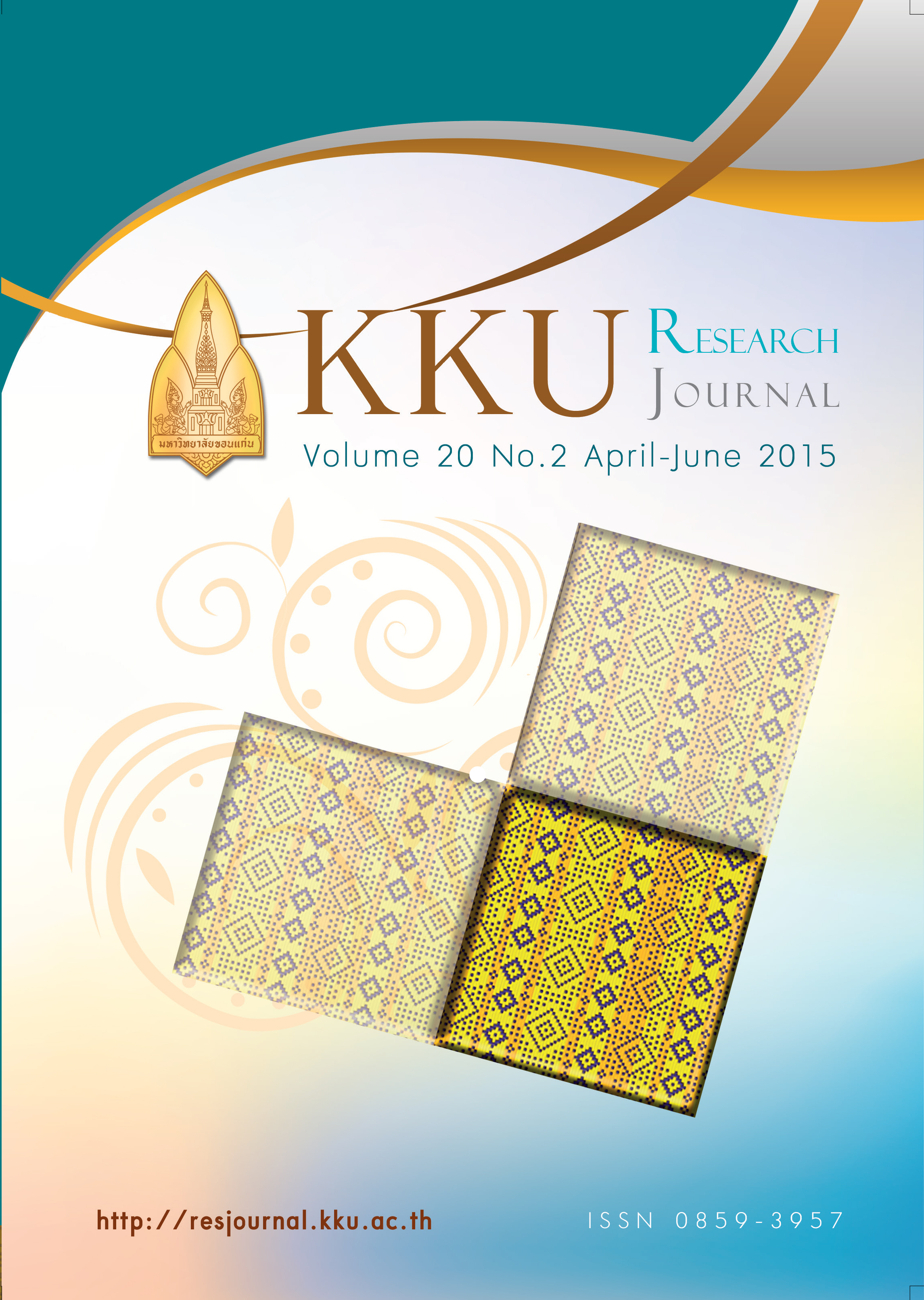3D photochemical dispersion models for secondary air pollutant study: from input data preparation to model performance evaluation
Main Article Content
Abstract
Secondary air pollutants are formed through series of complex reactions occurred in the atmosphere under favorable meteorological conditions. Commonly known species are ozone and secondary aerosols, secondary inorganic and organic aerosols. Through its complexity, varieties of three dimensional (3D) photochemical dispersion models have been developed globally to simulate formations and dispersions of the secondary as well as the primary pollutants in the atmosphere. CMAQ and CAMx are the state of the science models under “one atmospheric approach”, noncommercial and open-source software. These characteristics are attracted and challenged for future air quality management via model simulations. Applications of CMAQ and CAMx are normally based on several steps: preparation of emission input, modeling set-up and model performance evaluation. This article presents the systematic procedures involved with the use of 3D photochemical models starting from theoretical principles for formation of secondary air pollutants, types of photochemical models and its associated physical and chemical modules, input data preparation including reviews on available emission inventories and lastly statistical methods for model performance evaluation.
Article Details
References
[2] Kevin WB. Toward the next generation of air quality monitoring: ozone. Atmospheric Environment. 2013; 80: 571-83.
[3] Kim Oanh NT, Permadi DA. Photochemical smog modelling for ozone air quality management. In: Hanrahan G, editor. Advances topics in environmental sciences: modelling of pollutants in complex environmental systems, volume I. Hertfordshire: ILM Publications; 2009. p. 291-317.
[4] Kukkonen J, Olsson T, Schultz DM, Baklanov A, Klein T, Miranda AI, et al. A review of operational, regional-scale, chemical weather forecasting models in Europe. Atmospheric Chemistry and Physics. 2012; 12: 1-87.
[5] Simon H, Baker KR, Phillips S. Compilation and interpretation of photochemical model performance statistics published between 2006 and 2012. Atmospheric Environment. 2012; 61: 124-139.
[6] Permadi DA, Murray F, Kim Oanh NT. Regional-scale modeling for projection of ozone air quality and potential effects on agricultural crops in Southeast Asia. In: Kim Oanh NT, editor. Integrated air quality management-ASEAN case studies. Florida: CRC Press; 2013. p. 199-220.
[7] Seinfeld JH, Pandis SN. Atmo-spheric chemistry and physics: from air pollution to climate change. 2nd ed. New Jessie: John Wiley & Son; 2006.
[8] Atkinson R. Atmospheric chemistry of VOCs and NOx. Atmospheric Environment. 2000; 34: 2063-101.
[9] Jimenez JL, Jayne JT, Shi Q. Ambient aerosol sampling using the aerodyne aerosol mass spec-trometer. Journal of Geophysical Research. 2003; 108: 8425-37.
[10] KrollJH, Seinfeld JH. Chemistry of secondary organic aerosol: formation and evolution of low-volatility organics in the atmosphere. Atmospheric Environment. 2008; 42: 3593-624.
[11] Kroll JH, Chan AWH, NG NL, Flagan RC, Seinfeld JH. Reactions of semivolatile organics and their effects on secondary organic aerosol formation. Environmental Science and Technology. 2007; 41: 3545-50.
[12] Wang X, Zhang Y, Chen H, Yang X, Chen J. Particulate nitrate formation in a highly polluted urban area: a case study by single-particle mass spectrometry in Shanghai. Environmental Science and Technology. 2009; 43: 3061-66.
[13] Dassios KG, Pandis SN. The mass accommodation coefficient of ammonium nitrate aerosol. Atmospheric Environment. 1999; 33: 2993-3003.
[14] Meng Z, Dabdub D, Seinfeld JH. Chemical coupling between atmospheric ozone and particulate matter. Science. 1997; 277: 116-9.
[15] Nghiem LH, Kim Oanh NT. Evaluation of the mesoscale meteorological model (MM5) - community multi-scale air quality model (CMAQ) performance in hindcast and forecast of ground-level ozone. Journal of the Air and Waste Management Association. 2008; 58: 1341-50.
[16] Permadi DA, Kim Oanh NT. Episodic ozone air quality in Jakarta in relation to meteorological conditions. Atmospheric Environ-ment. 2008; 42: 6806-15.
[17] UNC. Operational guidance for the community multiscale air quality (CMAQ) modeling system version 5.0. North Carolina: University of North Carolina at Chapel Hill; 2010.
[18] ENVIRON. User’s guide: compre-hensive air quality model with extensions (CAMx) version 5.40. California: Environ International Corporation; 2011.
[19] Shrestha RM, Kim Oanh NT, Shrestha RP, Rupakheti M, Rajbhandari S, Permadi DA, et al. Atmospheric brown clouds [ABC] emission inventory manual. Nairo-bi: United Nations Environment Programme; 2013.(20)Vongmahadlek C, Pham TBT, Satayopas B, Thongboonchoo N. A compilation and development of spatial and temporal profiles of high-resolution emissions invento-ry over Thailand. Journal of the Air and Waste Management Association. 2009; 59: 845-56.
[21] Kanabkaew T. Assessment of effects from crop residue field burning on particulate matter air quality in Thailand [PhD thesis]. Pathumthani: Asian Institute of Technology; 2011.
[22] Zhang BN, Kim Oanh NT. Photo-chemical smog pollution in the Bangkok Metropolitan Region in relation to ozone precursor concen-trations and meteorological condi-tions. Atmospheric Environment. 2002; 36: 4211-22.
[23] Kanabkaew T, Kim Oanh NT. Development of spatial and temporal emission inventory for crop residue field burning. Environmental Modeling and Assessment. 2011; 16: 453-64.
[24] USEPA. Guideline for the regulatory application of the urban airshed model. North Carolina: Research Triangle Park; 1991.
[25] Boylan JW, Russell AG. PM and light extinction model performance metrics, goals, and criteria for three-dimensional air quality models. Atmospheric Environment. 2006; 40: 4946-59.
[26] Morris RE, Koo B, Guenther A, Yarwood G, McNally D, Teshe TW, et al. Model sensitivity evaluation for organic carbon using two multi-pollutant air quality models that simulate regional haze in the Southeastern United States. Atmospheric Environment. 2006; 40: 4960-72.
[27] USEPA. Guidance on the use of model and other analyzes for demonstrating attainment air quality goals for ozone, pm2.5 and regional haze. North Carolina: Research Triangle Park; 2007.
[28] Kim Oanh NT, Permadi DA, Bao-Ning Z, Quang Huy TN, Phuong NL, Kanabkaew T, Iqbal A. Applications of photochemical smog models for assessment of ozone, particulate matter air quality, and acid deposition in Asian Cities. In: Kim Oanh NT, editor. Integrated air quality management-ASEAN case studies. Florida: CRC Press; 2013. p. 151-198.


